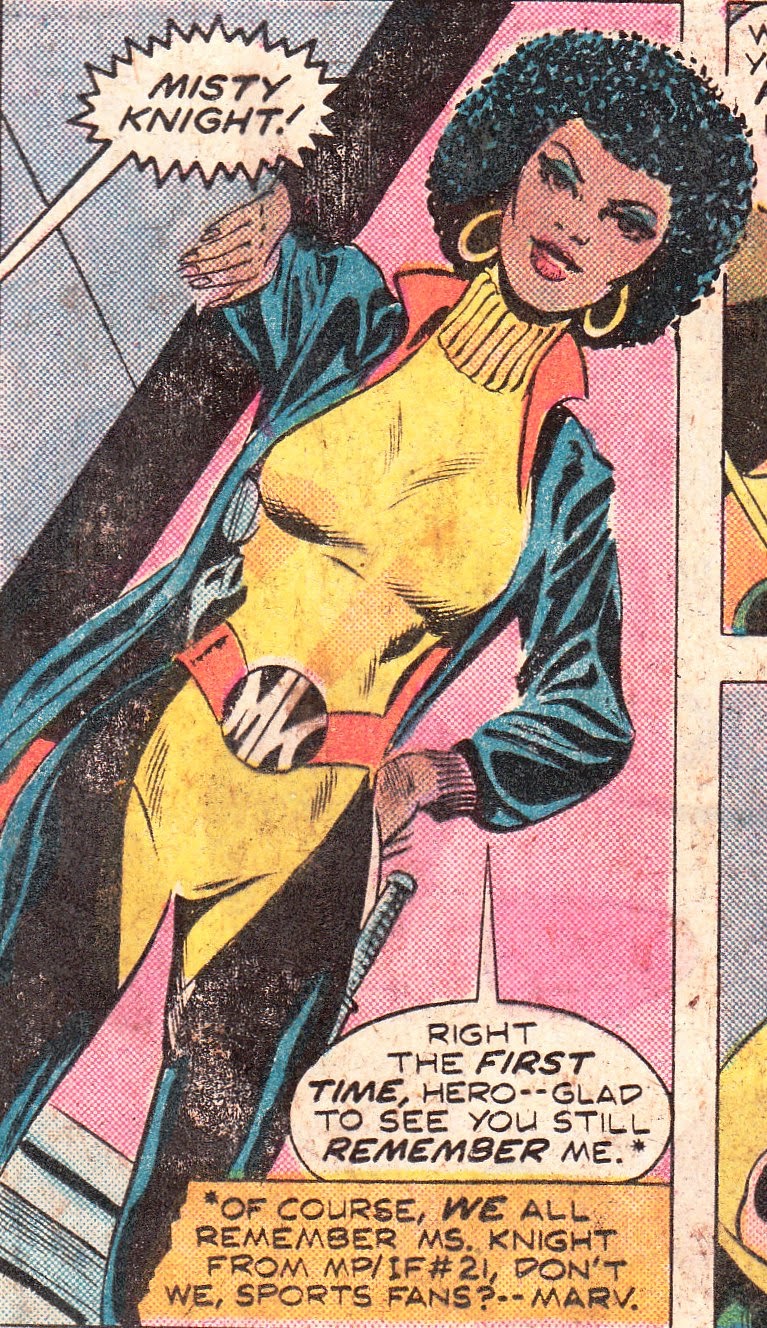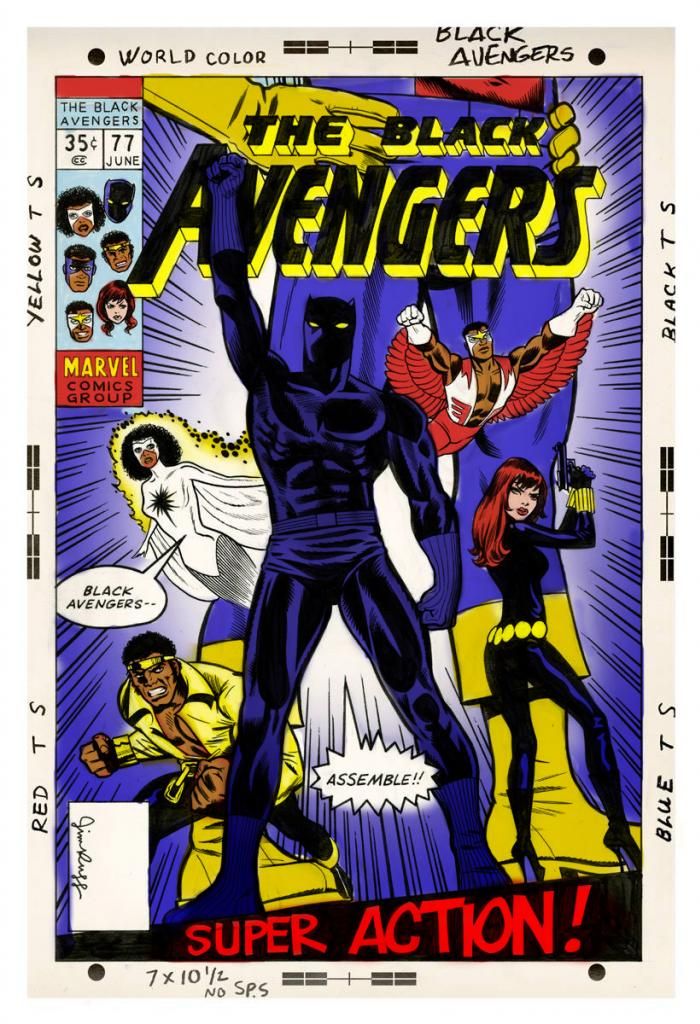In the 70's the comics, like the rest of America, began to become desegregated. but it didn't all happen at once. It took some time before blacks were integrated into the mainstream superhero books and even got books of their own.
Black Americans had a hard fight to be accepted as equal in America. Their fight was particularly strong in the 60's with Martin Luther King and Malcolm X (who were both assassinated for their efforts). Just like the rest of American culture, the comics almost never had heroes of color. It wasn't until the 60's, with the Civil Rights Movement in full swing that black heroes start to show up. The first black hero to appear in mainstream comics was Stan Lee and Jack Kirby's Black Panther from the pages of the Fantastic Four.
| Avengers #87, April 1971. |
Fast forward to 1973, Don McGregor, assistant editor of Jungle Action, asked why an African didn't appear in Marvel's jungle title that took place in African jungles. Well Don got himself a writing job.
Using the Black Panther, Don created a grand story arc that spanned 13 issues about an uprising in his African kingdom of Wakanda and then for the second story arc, in a very controversial move, he pitted him against none other than the Klu Klux Klan!
 |
| Jungle Action #19, Jan 1976 |
 |
| Black Panther #1, Jan, 1977, written and illustrated by Jack Kirby on his return to Marvel. |
It was pretty bold of Stan and Marvel to address such a controversial subject as racism so head on. They made it clear where their stance on the subject was. Later Bill would go on to become Black Goliath, a size changing hero like Pym, as told in Power Man #24 (April 1975) by Tony Isabella and George Tuska. And later still, in February 1976, he would get his own short lived series.
 |
| Black Goliath #1, Feb 1976 by Tony Isabella and George Tuska |
The next big black hero in Marvel's stable was the Falcon. He first appeared in Captain America #117, Sep. 1969 as a Caribbean vagabond who helped out Cap fight some Nazis.
 |
| Captain America #117, Sep. 1969 by Stan Lee and Gene Colan |
Gene Colan, artist and co-creator has said about Sam Wilson, the Falcon;
"...in the late 1960s [when news of the] Vietnam War and civil rights protests were regular occurrences, and Stan, always wanting to be at the forefront of things, started bringing these headlines into the comics. ... One of the biggest steps we took in this direction came in Captain America. I enjoyed drawing people of every kind. I drew as many different types of people as I could into the scenes I illustrated, and I loved drawing black people. I always found their
He went on to co-star in Cap's book and even had a short lived membership with the Avengers.
DC Comics was much later to jumping on the civil rights band wagon. Ironically it was the same guy who created the first black hero at Marvel who did it at DC. Jack Kirby was hired on at DC to work on the 4 title series which was called the New Gods. Within this pantheon of characters were two men of color; The Black Racer and Vykin the Black. They were minor characters with names derivative of their skin color but they were a start.
 |
| The Black Racer and Vykin the Black created by Jack Kirby |
The next black hero at DC Comics was John Stewart, who took over the Green Lantern mantle while Hall Jordan was unavailable. John Stewart was created by the legendary team of Dennis O'Neil and Neal Adams the team responsible for the classic, controversial Green Lantern/Green Arrow run which many say herald in the Bronze Age of comics.
 |
| Green Lantern vol. 2, #87 (Dec 1971) |
The first black hero to get his own book was Luke Cage, a.k.a. Power Man, in his title Hero for Hire as written by Archie Goodwin and drawn by George Tuska and African-American comic book artist Billy Graham.
 |
| Luke Cage, Hero for Hire #1, (June, 1972) |
 |
| From Hero for Hire #15, Nov 1973, as told by Tony Isabella, and Billy Graham |
With the success of Luke Cage, many other black heroes started to pop up like -
Blade created by Marv Wolfman and Gene Colan in the pages of Tomb of Dracula #10, July 1973
and Brother Voodoo created by Len Wein and Gene Colan in the pages of Strange Tales #169, Sep. 1973.
Brother Voodoo was Marvel's attempt to combine the new trend of supernatural heroes with that of the black hero. It was a great attempt but didn't really take hold as he only lasted 5 issues.
By the mid 70's I guess they felt that it was time to give women of color some representation. African mutant and demi goddess, Storm was created by Lien Wien and Dave Cockrum to help fill the ranks of the all new X-Men (May 1975).
Around the same time Tony Isabella created a strong black woman as part of the supporting cast of Iron Fist though it wasn't until Chris Claremont came along did she become a regular and take on her signature bionic arm. Misty Knight was born in Marvel Premiere #20 (January 1975) but was more fully developed by Chris Claremont in his and John Byrne's run of Iron Fist.
 |
| picture from Iron Fist #1, Nov. 1975 by John Byrne |
Besides a few flashes in the pane, DC was very late to joining the segregated ranks of comicbook heroes. It wasn't until Teen Titans #44, Nov 1976, that they got a regular member in any of their books. Mal Duncan appeared as the New Guardian (and later the Hornblower) in the Teen Titans and after which his girlfriend Karen Beecher became DC Comics first female African-American hero, Bumblebee, first appeared in Teen Titans #48, June 1977.
 |
| Here we see the Teen Titans with Bumblebee and Mal Duncan as Hornblower from Teen Titans #49, Aug 1977, by Bob Rozakis, with art by Jose Delbo |
 |
| Black Lightning #1, (April 1977) by Tony Isabella and Trevor Von Eeden |
So a year later DC decided that they should give a black heroin her own title as well. Vixen was created by Gerry Conway and Bob Oksner.
 |
| Vixen #1, Nov. 1978 that never made it to the newsstand. Created by Gerry Conway and Bob Oksner |
 |
| Action Comics #521, July 1981 |
It's been a long haul for African-Americans in comics. Things are not perfect but they are definitely much better than they once were.








.jpg)

because even the , black lives mattered ;)
ReplyDelete*then
ReplyDeleteVery interesting blog. Alot of blogs I see these days don't really provide anything that I'm interested in, but I'm most definately interested in this one. Just thought that I would post and let you know. Website
ReplyDelete